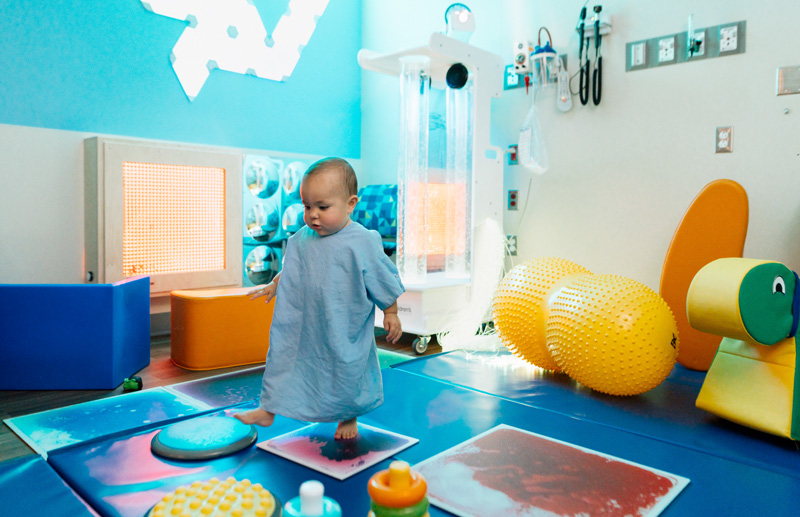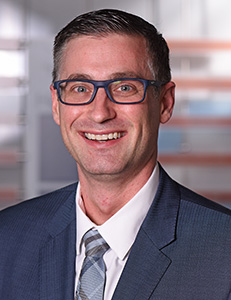Going to the hospital is typically accompanied by fear and stress, which is never easy for any family. For parents of children with autism, it can be even more overwhelming to think about going to the doctor’s office or the hospital. 95% of children with autism also have sensory processing differences (Kranowitz, 2022), and the sensory-friendly hospitals are hard to find. Typically, the hospital is filled with novel sensory experiences. Visually, there are bright lights, unfamiliar people, and intimidating machines. There are sounds of babies crying and monitors beeping. The room smells of sterile cleaning wipes and people’s perfumes. The medicine often tastes bitter, and the food in the cafeteria is unfamiliar to your child and not what they’re used to eating. The blankets might be thin and rough, and everything seems to be attached with sticky tape. If your children have sensory processing differences with their vestibular, proprioceptive, or interoceptive senses, they may feel uncomfortable sitting on the bed as it is wheeled down the hallway quickly, or maybe they don’t recognize the sensation of needing to use the bathroom when the nurse is waiting on a urine sample. On top of all these potentially stressful sensory experiences, there may be communication challenges between your child and health care providers, and there will likely be a lot of waiting time and multiple transitions (Muskat et al., 2014). These factors may make you dread taking your child to doctor visits or the hospital setting.

Beds can be removed from the sensory room to create a space of exploration for our sensory seeking patients
As health care providers, we know that it’s not easy coming to the hospital, which is why Dayton Children’s Hospital prioritizes making adaptations to care to help children with autism come through our hospital doors. One of the key areas of our support is creating individualized coping plans with caregivers. The role of parents is critical for the successful care of children with autism in the hospital setting (Muskat et al., 2014). Families report that having a behavioral care plan for their child normalizes the experience, promotes safety, and creates a better sensory-friendly hospital experience (Liddle et al., 2018; Winterberg et al., 2022; Broder-Finger et al., 2016). Children with autism were found to experience fewer challenges with anxiety and coping when they have adaptive care plans (Liddle & Sonnentag, 2020). Our organization’s team of certified child life specialists contacts families before appointments to discuss how their child does in the hospital setting and how staff can make visits as easy as possible. Child life specialists are a standard of care in our surgery department, medical imaging department, and ophthalmology clinic that contact families before an appointment to learn about a patient’s triggers, communication methods, interests, and sensory sensitives. While used during a child’s appointment, the information is available in the patient’s chart for unexpected admissions or emergency department visits.
The other intervention is sensory rooms in our pre-op unit and lab, along with portable items used to create an adaptive sensory environment anywhere in our hospital. Sensory adaptive environments are often used in the dental setting to support positive coping and reduce pain and sensory discomfort, allowing for successful outcomes during dental visits (Shapiro et al., 2009; Cermak et al., 2015; Fallea et al., 2022). Our sensory rooms include adjustable lights and projectors, bubble tubes, weighted blankets, textured toys, gel floor tiles, floor mats, and various sensory toys. These rooms are adapted based on the child’s particular needs identified in the coping plan, and the environment is enriched with items depending on whether the patient is seeking or avoiding sensory stimulation. For example, certain triggers, such as the hospital bed, can be removed and replaced with sensory chairs or the floor mat. For patients who might benefit from a sensory room but have an appointment in another part of the hospital setting, our child life specialists use portable carts with sensory items to create an adaptive sensory environment wherever the patient is meeting with their health care providers.
Not every hospital has established support systems, such as child life specialists, coping plans, or sensory rooms. Still, there are ways caregivers can help make hospital visits a little easier. The first thing to do is share background information about your child with health care professionals because you are the expert on your child (Muskat et al., 2014). Talk to staff about how your child communicates their wants or needs, how they express when they’re anxious, and how you know when your child is in pain. Behavior is communication, so let staff know if there are behavioral changes that help you understand what your child is thinking or feeling. Communicate to staff if there are triggers and what the best way to respond is when your child is upset. For example, should staff continue a procedure until it is complete, as quickly as possible, or does your child do best if given a short break to recover? Share with staff if your child is sensory seeking or sensory avoiding and their sensory sensitives. Every child is different, and you, as the caregiver, know what’s best for your child and be the advocate so that care can be unique and tailored to your child (Fraatz & Durand, 2021).
Even at hospitals that are not equipped to help children with sensory processing difficulties, there are adaptations that you can do to make the environment easier to manage. This may include turning down the lights, removing or rearranging furniture in the room, requesting a bigger room or one further down the hall and away from the crying baby’s room, or putting a sign on the door to remind staff of important information about your child. If the hospital doesn’t have sensory items, such as projectors or weighted blankets, maybe an extra lead apron can be borrowed from an X-ray, or a crib projector from an infant care space can be used for your child. For outpatient visits, some families find it helpful to wait to do vitals and blood pressure until the end if it escalates their child. Advocate for an appointment based on what time works best for their child’s routine and potentially request that you break a long clinic visit into two separate appointments to limit how much waiting your child will need to do while you talk to the health care providers. Before a visit or a procedure, prepare yourself and your child so you know what to expect. Reach out to the hospital to see if they have child life specialists who can provide developmentally appropriate education or ask for details about the procedure so you can figure out how to best prepare your child. Some families find the visual schedule or preparation books help make procedures easier.
Every hospital has different systems in place and resources available for families during the stressful experience of coming to the hospital. But the one thing your child always has is you. You, the caregiver, know your child best; you know what works and what doesn’t. You’ve been with your child for their previous hospital experiences, while the staff caring for them have often just met your child for the first time. Even if your child has minimal exposure to the hospital, you’ve supported your child through a variety of new or stressful experiences. Tell the staff if there are strategies you’ve developed or identified for taking vitamins, getting haircuts, or anything hard for your child to get through. Create your coping plan outlining triggers, communication, interests, and who your child is to share with hospital caregivers. They rely on you as the expert on your child, and you are the best resource for support.
Elise Huntley, MA, CCLS, is a Certified Child Life Specialist who supports patients with sensory needs in the outpatient setting. As a member of the child life team at Dayton Children’s Hospital, Elise develops individualized coping plans for patients with developmental disabilities before hospital visits, using this information to create individualized adaptive sensory environments. She may be contacted at huntleye@childrensdayton.org.
Sean Antosh, MD, is a Board-Certified Pediatric Anesthesiologist with clinical interests in improving the perioperative experience and care of children with Autism Spectrum Disorders. He is the current chair of the Society for Pediatric Anesthesia special interest group for Perioperative Care of Children with Special Developmental and/or Behavioral Health Needs. He may be contacted at antoshs@childrensdayton.org.
To learn more about the Dayton Children’s Hospital sensory program, please visit www.childrensdayton.org/the-hub/our-sensory-program-sets-gold-standard-patient-care.
References
Bevan, S., Harris, K. A., Maeder‐Chieffo, S., Reswebber, E., Lanahan, D., & Souders, M. C. (2023). Positive healthcare encounters for children with autism spectrum disorder: accommodations during surgical procedures. Journal of PeriAnesthesia Nursing, 38(1), 6–11. https://doi.org/10.1016/j.jopan.2022.05.070
Broder‐Fingert, S., Shui, A., Ferrone, C., Iannuzzi, D., Cheng, E. R., Giauque, A. L., Connors, S. L., McDougle, C. J., Donelan, K., Neumeyer, A. M., & Kuhlthau, K. (2016). A pilot study of Autism-Specific care plans during hospital admission. Pediatrics, 137(Supplement_2), S196–S204. https://doi.org/10.1542/peds.2015-2851r
Cermak, S. A., Duker, L. I. S., Williams, M. E., Dawson, M. E., Lane, C. J., & Polido, J. C. (2015). Sensory Adapted Dental Environments to Enhance Oral Care for Children with Autism Spectrum Disorders: A Randomized Controlled Pilot Study. Journal of Autism and Developmental Disorders, 45(9), 2876–2888. https://doi.org/10.1007/s10803-015-2450-5
Fallea, A., Zuccarello, R., Roccella, M., Quatrosi, G., Donadio, S., Vetri, L., & Calı, F. (2022). Sensory-Adapted Dental Environment for the Treatment of Patients with Autism Spectrum Disorder. Children (Basel), 9(3), 393. https://doi.org/10.3390/children9030393
Fraatz, E., & Durand, T. M. (2021). Meeting the needs of children with autism spectrum disorder and their families in hospital settings: the perspectives of certified child life specialists and nurses. The Journal of Child Life Psychosocial Theory and Practice, 2(2). https://doi.org/10.55591/001c.27703
Hudson, J. (2006). Prescription for success: Supporting Children with Autism Spectrum Disorders in the Medical Environment. AAPC Publishing.
Kranowitz, C. S. (2022). The Out-of-Sync Child, third Edition: Recognizing and Coping with Sensory Processing Differences. Penguin.
Liddle, M., & Sonnentag, T. L. (2020). Effectiveness of Adaptive Care Plans for Children with Developmental Disabilities During Outpatient Clinic Appointments. Journal of Autism and Developmental Disorders, 51(9), 3028–3038. https://doi.org/10.1007/s10803-020-04764-1
Liddle, M., Birkett, K., Bonjour, A., & Risma, K. A. (2018). A collaborative approach to improving health care for children with developmental disabilities. Pediatrics, 142(6). https://doi.org/10.1542/peds.2018-1136
Miller, L. J. (2014). Sensational Kids: Hope and Help for Children with Sensory Processing Disorder (SPD). National Geographic Books.
Muskat, B., Riosa, P. B., Nicholas, D., Roberts, W., Stoddart, K. P., & Zwaigenbaum, L. (2014). Autism comes to the hospital: The experiences of patients with autism spectrum disorder, their parents and health-care providers at two Canadian paediatric hospitals. Autism, 19(4), 482–490. https://doi.org/10.1177/1362361314531341
Pina‐Vaz, I. (2010). Improving the management of children with learning disability and autism spectrum disorder when they attend hospital. Child: Care, Health and Development, 36(6), 753–755. https://doi.org/10.1111/j.1365-2214.2010.01144.x
Shapiro, M., Sgan‐Cohen, H. D., Parush, S., & Melmed, R. N. (2009). Influence of Adapted Environment on the Anxiety of Medically Treated Children with Developmental Disability. The Journal of Pediatrics, 154(4), 546–550. https://doi.org/10.1016/j.jpeds.2008.10.017
Winterberg, A. V., Jones, E., Ding, L., Hill, L., & Varughese, A. M. (2022). Adaptive care for perioperative patients with developmental disabilities: an exploration of interventions and family experience. Journal of Pediatric Health Care, 36(6), 529–539. https://doi.org/10.1016/j.pedhc.2022.05.019







